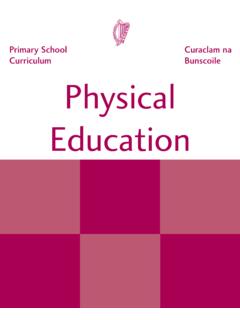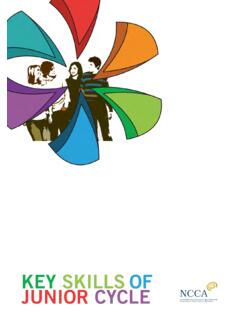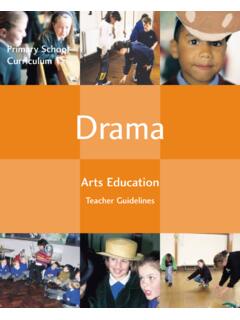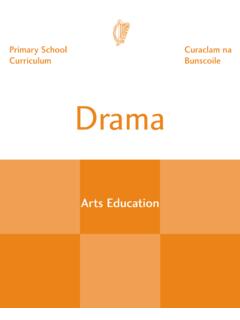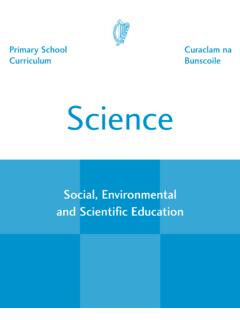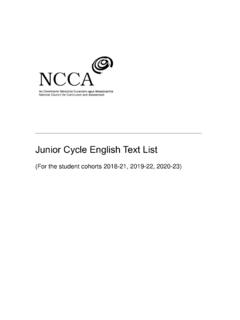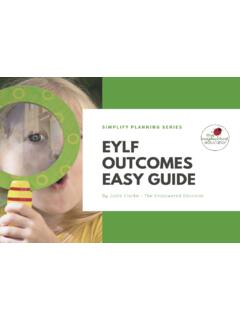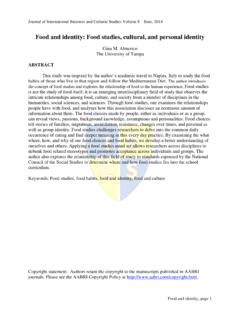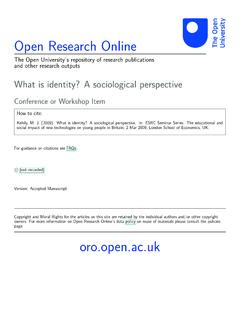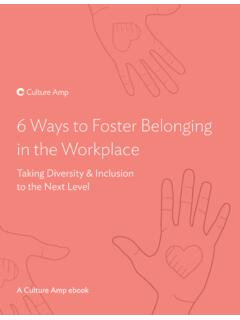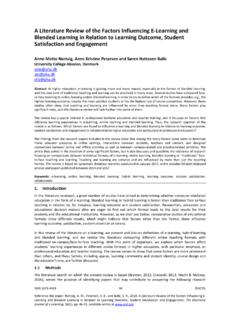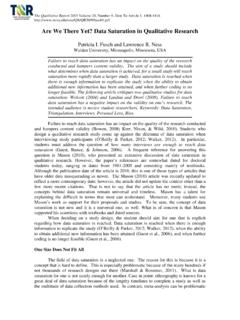Transcription of Identity and Belonging - Curriculum
1 < strong >Identitystrong > and < strong >Belongingstrong > Aistear: the Early Childhood < strong >Curriculumstrong > Framework < strong >Identitystrong > and < strong >Belongingstrong > Theme: < strong >Identitystrong > and < strong >Belongingstrong > The theme of < strong >Identitystrong > and < strong >Belongingstrong > is about children developing a positive sense of who they are, and feeling that they are valued and respected as part of a family and community. From birth, children develop a sense of who they are. Relationships with family members, other adults and children, friends and members of their community play a key role in building their identities. Children's sense of who they are is shaped by their characteristics, their behaviour, and their understanding of themselves, their family and others. < strong >Belongingstrong > is about having a secure relationship with or a connection with a particular group of people. When children feel a sense of < strong >Belongingstrong > and sense of pride in their families, their peers, and their communities, they can be emotionally strong , self-assured, and able to deal with challenges and difficulties.
2 This creates an important foundation for their learning and development. Giving children messages of respect, love, approval, and encouragement enables them to develop a positive sense of who they are and a feeling that they have an important contribution to make wherever they are. Positive messages about their families, backgrounds, cultures, beliefs, and languages help children to develop pride in who they are. These messages also give them confidence to voice their views and opinions, to make choices, and to help shape their own learning. By embracing difference, by exploring their own attitudes in relation to equality and diversity, and by realising that their attitudes and values influence children, adults can develop the insights, self-awareness and skills that are needed to help children develop a strong sense of < strong >Identitystrong > and < strong >Belongingstrong > .
3 This helps to ensure that all children are respected and valued and that they can recognise and deal with discrimination and prejudice. 25. Aistear: the Early Childhood < strong >Curriculumstrong > Framework < strong >Identitystrong > and < strong >Belongingstrong > Table 2: Aims and learning goals for < strong >Identitystrong > and < strong >Belongingstrong > < strong >Identitystrong > and < strong >Belongingstrong > Aims Learning goals Aim 1 In partnership with the adult, children will Children will have strong 1. build respectful relationships with others self-identities and will feel 2. appreciate the features that make a person special and unique (name, size, respected and affirmed as hair, hand and footprint, gender, birthday). unique individuals with their own life stories. 3. understand that as individuals they are separate from others with their own needs, interests and abilities 4. have a sense of who they are' and be able to describe their backgrounds, strengths and abilities 5.
4 Feel valued and see themselves and their interests reflected in the environment 6. express their own ideas, preferences and needs, and have these responded to with respect and consistency. Aim 2 In partnership with the adult, children will Children will have a sense 1. feel that they have a place and a right to belong to the group of group < strong >Identitystrong > where 2. know that members of their family and community are positively links with their family and acknowledged and welcomed community are acknowledged and extended. 3. be able to share personal experiences about their own families and cultures, and come to know that there is a diversity of family structures, cultures and backgrounds 4. understand and take part in routines, customs, festivals, and celebrations 5. see themselves as part of a wider community and know about their local area, including some of its places, features and people 6.
5 Understand the different roles of people in the community. Aim 3 Inpartnership with the adult, children will Children will be able to 1. express their views and help make decisions in matters that affect them express their rights and show 2. understand the rules and the boundaries of acceptable behaviour an understanding and regard for the < strong >Identitystrong > , rights and 3. interact, work co-operatively, and help others views of others. 4. be aware of and respect others' needs, rights, feelings, culture, language, background, and religious beliefs 5. have a sense of social justice and recognise and deal with unfair behaviour 6. demonstrate the skills of co-operation, responsibility, negotiation, and conflict resolution. Aim 4 In partnership with the adult, children will Children will see themselves 1. develop a broad range of abilities and interests as capable learners.
6 2. show an awareness of their own unique strengths, abilities and learning styles, and be willing to share their skills and knowledge with others 3. show increasing confidence and self-assurance in directing their own learning 4. demonstrate dispositions like curiosity, persistence and responsibility 5. experience learning opportunities that are based on personal interests, and linked to their home, community and culture 6. be motivated, and begin to think about and recognise their own progress and achievements. 26. Aistear: the Early Childhood < strong >Curriculumstrong > Framework < strong >Identitystrong > and < strong >Belongingstrong > Sample learning opportunities Babies The adult closely observes babies, knows their personalities well, respects and responds to their individual needs and preferences, and builds on care practices from home: knows babies' natural rhythms, supports sleeping and feeding routines, and provides favourite comfort objects, for example blanket, teddy, soother places photographs of parents near the sleeping area and knows at least a few words in the babies' home language when that language is neither English nor Irish responds appropriately to babies' feelings, for example soothes them when upset, builds on their curiosity, provides positive physical contact such as cuddling, hugging, and holding on the lap supports babies' emerging sense of < strong >Identitystrong > : helps babies understand and use their physical capabilities, for example encouraging them to clap hands, to reach, to smile, to wave, to point, and to talk using gurgles and sounds helps babies to distinguish themselves from others, for example says the babies'.
7 Names and the names of family members, looks at and points to photographs provides opportunities for babies to be with, to watch, and to listen to other children provides low level mirrors and reflective toys, such as activity cubes with safety mirrors attached, and describes what babies see to enable them to recognise their own reflection displays photos of babies and their work in the setting shows the daily routine through photographs, makes portfolios of babies'. constructions and paintings as they grow helps babies to identify body parts by pointing to, touching, and naming them, for example pointing to toes, wriggling fingers, tapping heads, touching ears provides opportunities for older siblings, peers and babies to see one another and to be together at different times during the day, optimising opportunities that will enable them to interact and communicate: plans activities and events when babies, siblings, and/or older children can be together, for example meal times, song-time, before going home ensures babies and siblings have time outside to play together regularly provides babies with experiences of the outside world.
8 Brings babies outside to explore and observe on a regular basis gives babies opportunities to see the outdoors, for example positions babies near low level windows where they have a view outside when they are inside 27. Aistear: the Early Childhood < strong >Curriculumstrong > Framework < strong >Identitystrong > and < strong >Belongingstrong > provides babies with natural items, pictures and books about nature, for example the weather, animals, and things that happen outside such as farming, travel, or buildings plans visits to places in the local community such as a park, a library, a playground, a market brings babies to the local parent-and-baby or parent-and-toddler group. Toddlers The adult plays with and observes toddlers and takes account of their interests, needs, rights and wishes: observes and listens carefully to what toddlers do and say, rephrases emergent speech to support language development in a positive way, for example when the toddler says, I want a t-poon, the adult responds with, Oh you want a spoon do you Amy?
9 Rather than saying, don't say t-poon Amy. empathises with and responds to toddlers when they are concerned or afraid respects and values things that are important to toddlers such as relationships, family, pets, objects, for example knows that the toddler loves tractors and extends his/her interest by having books about tractors, by having a farm set, or by visiting a real farm spends one-to-one time with toddlers to make them feel special and valued: plays with toddlers and completes tasks or projects together with them, follows the toddlers' leads, allows plenty of opportunity for interaction and affirmation reads favourite stories and introduces appropriate new stories goes for walks and chats with toddlers along the way provides opportunities for toddlers to be creative, for example making cards for special occasions, making and playing with different coloured play-dough, making a collage from junk materials displays toddlers' work showing their names and dates, for example photographs, constructions, paintings, collages gives toddlers an assigned space in which to put their things invites toddlers to talk about their news, experiences and feelings looks at toddlers' learning portfolios with them individually.
10 And talks about what they have achieved uses resources and materials which reflect toddlers' families, genders, abilities, backgrounds, and cultures: provides books and puzzles which represent a variety of family types, homes and 28. Aistear: the Early Childhood < strong >Curriculumstrong > Framework < strong >Identitystrong > and < strong >Belongingstrong > occupations, including those of the toddlers' parent/s, taking account of abilities, disabilities and cultures, beginning with who is in the setting and then extending it to the community plays with toddlers using dolls, including those with anatomically correct features that have a range of skin tones and hair types plays and responds to culturally appropriate and relevant music reads books about people of different appearances and abilities (including those with special needs), for example people who wear glasses or hearing aids, people who use wheelchairs, crutches or Zimmer frames, people who are on the autistic spectrum, or people with illnesses such as Alzheimer's or Parkinson's disease provides a range of colours in crayons and paints, and encourages toddlers to show different skin tones in their pictures plans the pretend play area to reflect the lifestyle of all toddlers attending, for example dress-up clothes, utensils, food, and cooking items in the pretend play area that are familiar to the toddlers, especially if they are from culturally diverse homes provides objects and tools similar to those used by the toddlers' parent/s at work.
